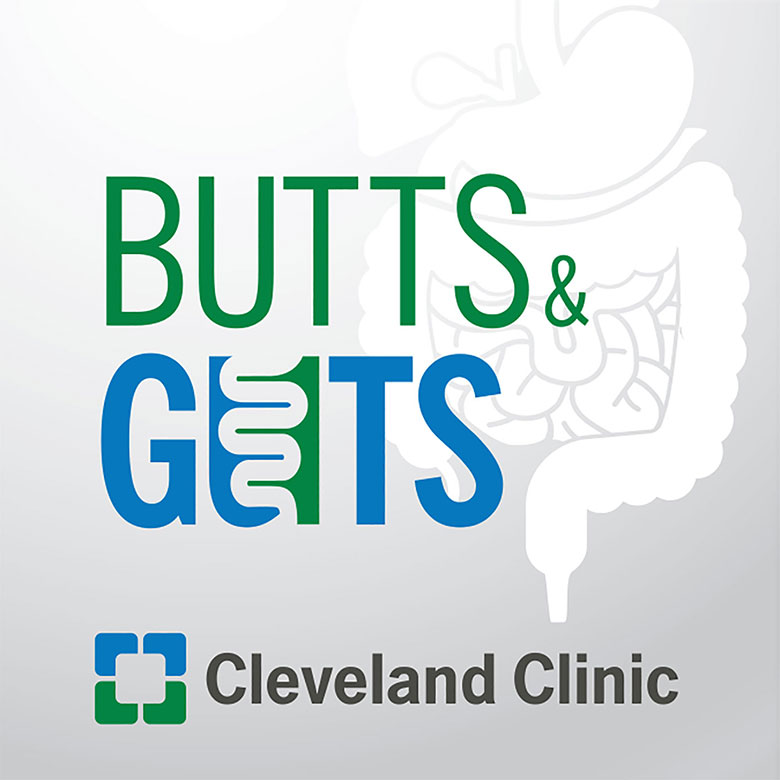J-Pouch and Redo J-Pouch Surgery

Join Cleveland Clinic colorectal surgeon Dr. Olga Lavryk, MD, as she discusses J-Pouch and redo J-Pouch surgery. This reconstructive procedure allows normal bowel movements for patients who have had their whole colon removed due to serious disease. Join this episode of Butts & Guts to learn about the benefits, side effects and risks associated with J-Pouch and redo J-Pouch surgery.
Subscribe: Apple Podcasts | Podcast Addict | Spotify | Buzzsprout
J-Pouch and Redo J-Pouch Surgery
Podcast Transcript
Scott Steele: Butts & Guts, a Cleveland Clinic podcast exploring your digestive and surgical health from end-to-end.
Hi again, everyone. Welcome back to another episode of Butts & Guts. I'm your host Scott Steele, colorectal surgeon and president of Main Campus here at the Cleveland Clinic in beautiful Cleveland, Ohio. Today I'm very pleased to have one of our own, Dr. Olga Lavryk, a colorectal surgeon here at the Cleveland Clinic. We're going to talk about something that we haven't talked about before and that's redo J-pouch procedures.
Dr. Lavryk, welcome to Butts & Guts.
Dr. Olga Lavryk: Thank you very much. Thank you for having me.
Scott Steele: Super excited to have you here. Like all of our guests here, we want to start first by telling us a little bit about your background. Where are you from, where did you train, and how did it come to the point that you're here now staff at the Cleveland Clinic?
Dr. Olga Lavryk: Thank you. I'm originally from Kiev, Ukraine. That's where I did my medical school. Afterwards, I came here for residency, I did my fellowship here. I fell in love with colorectal surgery as I had a great experience with my mentors who showed me the beauty of the specialty. That's my story in brief.
Scott Steele: Well, we're glad that you decided to stay here. Today we're going to be talking all about redo J-pouch procedures. Let's back it up one step to start. Can you explain to our listeners what a J-pouch is?
Dr. Olga Lavryk: Yeah. A J-pouch is a procedure that we can offer to patients who have lost the colon and rectum in series of different diseases, such as colitis or FAP, familial adenomatous polyposis, or Lynch syndrome for example, hereditary cancer syndromes. That's a procedure that offers to live not with a permanent ileostomy, which back about 50 years ago, would still be a procedure of choice. Now we're able to reconstruct the intestinal continuity by making a reservoir created from a small intestine.
Scott Steele: So you're making a new rectum out of the small bowel?
Dr. Olga Lavryk: Right. It's new rectum, but it's not a new rectum. That's something that we explain to our patients, that it won't function the same as a prior rectum, but has its role.
Scott Steele: That's fantastic. Now let's flash forward and talk about somebody gets a J-pouch. Why would they need a redo J-pouch procedure?
Dr. Olga Lavryk: Right. A J-pouch procedure itself is a very complex operation and having the very first attempt is the best attempt. It's a life-changing procedure. It has a quite high morbidity, such as leak of the connection, strictures, fistulas, poor function where patients can't empty it or can't use it as a new rectum. That's where a redo pouch comes into play. This is more complex procedure for, again, very motivated patients and very selective patients who do not want to live with a permanent stoma. If they don't want to have it, a permanent stoma is always another option.
Scott Steele: You mention some of the end results of needing a redo J-pouch procedure. But what are some of the more common reasons for a J-pouch to fail, or maybe even that requires revision?
Dr. Olga Lavryk: Right. Here we have the largest series of experience in the world in J-pouches, about 5000 patients. The highest reason for pouch failure is an anastomotic leak, which will happen in approximately 5% of patients. That is something for when a pouch can be salvaged and can be redone. Other complications can include, like I mentioned, fistulas which target the pouch. For example, if patient was to be diagnosed with ulcerative colitis, but down the road, even 10 or 20 years after the initial pouch had developed a Crohn's disease of the pouch. Or things like poor mechanical construction, patients can't empty it, or they have a long rectal cuff retained and that physiology needs to be redone.
Scott Steele: In addition to the obvious, can you explain the differences between an initial J-pouch surgery and a redo J-pouch procedure?
Dr. Olga Lavryk: Yes. Initial J-pouch surgery, depending on the indication, can be done either in two or three stages. If it's for colitis or inflammatory bowel disease, we would initially do a total colectomy, then removal on rectum, construction of this reservoir or J-pouch with a stoma, and then reverse the stoma. Usually, nowadays, it can be done either on the robotic platform or laparoscopically.
While a redo pouch, depending on the indication again, usually it's an open operation. If that's for septic complication, it requires quite a bit of adhesiolysis. And most important is to figure out if there is enough of the small bowel to construct a redo pouch. Sometimes in these cases, in order to prepare for redo pouch, we have to do a temporary ostomy to settle down the adhesions, and then go back and prepare for the actual redo J-pouch.
Scott Steele: What are some of the key factors that determine whether or not a patient is a good candidate for a redo J-pouch?
Dr. Olga Lavryk: First, we would want to make sure that there is enough of the small bowel to redo the pouch. We meticulously gather all the operative reports, if patients had any other bowel resections. In general, we would want to have enough reach of the small bowel down to the anus to redo this pouch. Afterwards, if a patient had a diagnosis of IBD or they want to make sure they don't have active Crohn's disease anywhere else in the small bowel because that simply will come back and the pouch won't have a good outcome. Of course, patients who had radiation to the pelvis, for example a history of rectal cancer and Lynch, they won't have a good function down the road. Generally, that's considered a contraindication.
Scott Steele: You mentioned earlier that the initial J-pouch procedure is a pretty complex procedure, maybe one of the more complex things that we do as colorectal surgeons. Are there potential risks or complications that are associated with a redo J-pouch procedure?
Dr. Olga Lavryk: Yes. Usually, that's a more lengthy operation and like I mentioned, usually is done an open operation. Slightly can be longer lengths of stay, just on the short term.
Just like after any other surgery, risk of an anastomotic leak. The connection of the redo pouch down to the anal canal usually is done by hand, a hand-sewn anastomosis. Those connections stand to narrow down just by the nature how they are constructed. It's a conversation with patients that, sometimes down the road, they might need to have dilatations to stretch that area in order to achieve good results. Immediately after surgery of course, we keep an eye for things like leak, injury to surrounding organs. In septic scenario, there can be quite a bit of pelvic bleeding. We're prepared. There is multidisciplinary approach to make sure that our anesthesia team and surgical team are prepared if that was to happen in the operating room.
Scott Steele: How does the recovery process maybe differ between the initial J-pouch surgery and a redo procedure?
Dr. Olga Lavryk: I would say that it, again, would come to patients' background and their indication. If the initial operation was done laparoscopically, just after any procedure, it will have a shorter length of stay. Normally, patients are able to go as soon as their ostomy is working, they are just tolerating low residue diet well. After redo pouch, if it's an open operation, they will have a higher chance of ileus and a longer stay, higher risk of having anastomotic complication. But we just keep a close eye on everything, and down the road, have a close follow-up even if patients are from out of state by using telemedicine and keeping a very close eye on everything.
Scott Steele: How do you manage and address complications? I completely recognize there may be a lot of different types, but in general, some of these complications that may arise after this procedure.
Dr. Olga Lavryk: In general, right after the construction of the J-pouch, it's done with a temporary divergent ostomy, again. Patients needs to be willing to have that. A lot of times, patients just want to have a redo pouch and not willing to have an ostomy, but that's a necessary step. Sometimes we will do, and usually we will do a Gastrografin enema. We want to make sure the connection is well-healed and there is no leak before we reverse the ostomy. Sometimes we might consider doing an examination under anesthesia of that connection to make sure there is no narrowing and things are patent and they will work well before we reverse the ostomy.
If we were to diagnose any kind of complication like abscess, leak or stynas that potentially can elude a longer need for a divergent ostomy. Not meaning that it's forever, but sometimes it cannot be just three or six months, sometimes longer. As long as necessary, up until we're sure that the pouch will function well.
Scott Steele: Aside from some of the complications, what lifestyle changes or adjustments might be necessary for patients with these J-pouches?
Dr. Olga Lavryk: Yeah. This comes to the technique of the construction, and again back to this hand-sewn anastomosis, where we attempt to preserve that dentate line which is responsible for the simple reflex and the patient to feel when they want to pass gas or have defecatory action. When we do these connections by hand, outcomes for that tends to be slightly worse with slightly higher rates of seepage at nighttime, or maybe some stool seepage during the daytime, compared to when it is done with a staple device. But overall from experience, here we know that majority of patients despite that still want to undergo this surgery, would recommend it to others, and think that it's a life-changing procedure for them.
Scott Steele: I can imagine that somebody who had an initial J-pouch procedure, that's a life-altering event that can be filled with anxiety or concern. Then now, we're telling them that they may need to have a redo J-pouch procedure. What advice do you give to those patients who are anxious or concerned about that?
Dr. Olga Lavryk: Yes. First, it will be important to really understand what is patient's goal, why they want to have a redo pouch. It's important to set the expectations with them to understand that it's not just one big surgery and then they are done. It's a series of events. A lot of times, we have to prepare them for the surgery. We have to do a bag for six months before we actually go back into that pelvis. Patients have to understand then they need to be motivated to go through that process and be part of the team with us. This surgery is only for patients who are very motivated and want to be a part of the time. Like I said, an ostomy is definitely an option. Of course, this is where it comes into play, the continent ileostomy, which will provide the opportunity for patients not to wear a bag on the outside, but to intubate the inner intestinal reservoir and to empty their bowels, and just cover the abdomen with a piece of gauze or tape.
Scott Steele: You mentioned the continent ileostomy or a K-pouch. Can you delve into that a little bit? And are there any other advancements or new techniques in redo J-pouch surgeries?
Dr. Olga Lavryk: Yeah. The continent ileostomy is something that actually started even before the J-pouch procedure was adapted. What it is is also an intestinal reservoir that has a continent valve. It prevents the stool continent just to leak out and patient doesn't need to wear a bag. What they need to do, they need to learn how to intubate that and empty, usually around the clock or four times a day. With that, it simply has to do with patients' quality of life, and again their choice. In addition, we have to make sure there is enough of bowel to do it. Here we have, again, the largest experience of those, it's a conversation between a patient and a surgeon, if they're willing to go through the learning curve how to use it.
In terms of the new techniques in the redo J-pouch, it all comes to the multidisciplinary approach to diagnose what is the reason for the pouch failure. Nowadays, we can use artificial intelligence in order to remodel and reconstruct and index pouch's anatomy, and afterwards figure out what was done with it wrong, where the staples not used properly, and then implement it in future redo pouch strategies.
Scott Steele: Yeah, that's very exciting. Now it's time for our quick hitters, a chance to get to know our guests a little bit better. First of all, what was your first car?
Dr. Olga Lavryk: Škoda
Scott Steele: What is that?
Dr. Olga Lavryk: That comes from Czech, it's a very popular car in Ukraine. It was a manual, and I got it when I was a fourth-year medical student.
Scott Steele: Fantastic. What is your favorite dessert?
Dr. Olga Lavryk: Panna cotta. It's a jello dessert that is made from raspberry and milk.
Scott Steele: Fantastic. What was a favorite trip that you've been on?
Dr. Olga Lavryk: I had a pleasure of being in Italy for about a month last year, and that's where I also grew up for a couple years. It was one of the best I have spent.
Scott Steele: Fantastic. Finally, do you have a hidden talent that you can tell us about?
Dr. Olga Lavryk: Probably the fact that, in my past life, I did skiing on a professional team. That was in my past and I really enjoyed it.
Scott Steele: That's fantastic. Give us a final take home message for our listeners regarding redo J-pouches.
Dr. Olga Lavryk: I would say this is one of those salvage options that is out there and is available for patients who are seeking to not live with a permanent ostomy. I would recommend this surgery to be done in high volume centers and surgeon's hand who do a lot of these. It's a very complex operation. If a patient's willing to go through it, I would recommend to do it in a big center. Certainly, if a patient is not willing to have it done, they don't have to. The goal here is to allow patients to have the best quality of life and to enjoy life.
Scott Steele: That's fantastic. To learn more about redo J-pouch procedures, or to connect with the colorectal surgery team here at the Cleveland Clinic, please call 216.444.7000. That's 216.444.7000. You can also visit our website at clevelandclinic.org/digestive. That's clevelandclinic.org/digestive.
Dr. Lavryk, thanks so much for joining us on Butts & Guts.
Dr. Olga Lavryk: Thank you so much for having me.
Scott Steele: That wraps things up here at Cleveland Clinic. Until next time, thanks for listening to Butts & Guts.



